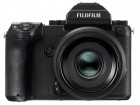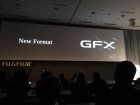
EXCLUSIVE: Hands-on with Fujifilm 100MP GFX Announced back at Photokina in September 2018, Fujifilm's next-generation GFX medium-format camera is getting closer to becoming reality. Sporting a 100MP BSI CMOS sensor and built-in image stabilization, the GFX 100 represents a significant evolution of the GFX 50S, which debuted the basic body shape and control philosophy of Fujifilm's current medium-format lineup.
We're at the Gulf Photo Plus event in Dubai, where Fujifilm gave us a sneak peek at the first working prototype of the upcoming camera, to see for ourselves how it's shaping up. Click through for a closer look.
EXCLUSIVE: Hands-on with Fujifilm 100MP GFX
This is an early prototype, with many key features in-place and working, but not all. This particular camera is literally 'unfinished' in another sense, because it's still waiting for its final cladding. The current smooth rubber covering will be replaced by a textured finish, similar to that used on the GFX 50S.
EXCLUSIVE: Hands-on with Fujifilm 100MP GFX
At a casual glance, the GFX 100 looks a lot like a GFX 50S with a lighter gray finish and battery grip attached, and from an ergonomic point of view that's not too far off being accurate, in many respects. The 'grip' is integral to the camera, providing more space inside the body for large components like the mechanical shutter and IBIS unit, which has to stabilize a sensor 1. 7X the size of full-frame (43. 8mm x 32. 9mm).
With the relatively lightweight GF 45mm F2. 8 attached, the GFX 100 feels more like a professional full-frame DSLR than a medium-format mirrorless camera. Exact dimensions and final weight are still secret, but my sense from handling the GFX 100 with the 45mm F2. 8 is that it has about the same kind of heft as something like a Nikon D5 or Canon EOS-1DX II with a fast prime attached.
EXCLUSIVE: Hands-on with Fujifilm 100MP GFX
From the top, the GFX 100 starts looking a lot less like the GFX 50S that went before it. It's blockier and a little more industrial-looking for a start, and lacks the retro-style dials that are a characteristic of previous GF and X-series cameras.
A large high-contrast information panel dominates the upper right of the top-plate, while a large 3-position dial on the left is used to switch the camera between movie, stills and multiple exposure modes. The 'drive' button at its center allows you to determine your desired frame-rate, in combination with the camera's control dials.
EXCLUSIVE: Hands-on with Fujifilm 100MP GFX
The top screen on this prototype is not fully activated, but it will show a comprehensive status display of major exposure parameters, including exposure compensation. It is hoped that in this way, users of the new camera won't miss the large shutter speed and ISO dials of its predecessor too badly.
A major and very welcome change in the GFX 100 compared to the earlier 50S is the electronic viewfinder. At Fujifilm's request I have to be a little vague about the exact specifications of the finder, but I can tell you that in terms of clarity and resolution it compares well to the excellent EVF in the X-H1, and is free from the pixelation and noticeable lag which affected the finder of the 50S, especially when autofocus was initiated.
EXCLUSIVE: Hands-on with Fujifilm 100MP GFX
Just like the GFX 50S, the viewfinder unit is removable, and will be interchangeable with the viewfinder from the earlier camera. However, GFX 50S users hoping to save some money might be disappointed - when the GFX 50S finder is attached to the GFX 100, they won't get the benefit of the greatly improved resolution of the newer EVF.
EXCLUSIVE: Hands-on with Fujifilm 100MP GFX
From the rear, more differences compared to the GFX 50S are obvious. The focus mode dial has been swapped from the left to the right of the viewfinder, playback has been relocated to the lower right of the screen, and the 4-way controller of the older camera has been deleted entirely.
As well as the larger top-mounted display there's an all-new OLED ribbon display on the back, below the main LCD. Not activated in this prototype, the intention is that this display will serve to show the status of key camera settings. I was hoping it might be touch sensitive, but apparently not.
EXCLUSIVE: Hands-on with Fujifilm 100MP GFX
The rear LCD assembly isn't quite flush with the rest of the rear controls but it sticks out a lot less than the original GFX, partly because of the relocation of the large battery to below the screen, inside the grip.
Like the GFX 50S, the main rear display is tilting and touch-sensitive, which is good because also like the 50S, the small rear joystick (which is duplicated in the GFX 100) is rather small and recessed. Setting AF point by touch might be a little easier in some situations, especially when the camera is tripod mounted.
EXCLUSIVE: Hands-on with Fujifilm 100MP GFX
Here's a closer look at the duplicated controls on the integrated vertical grip. While the main shutter dial has an on/off switch collar, the same control on the secondary shutter release serves to lock/unlock the button.
EXCLUSIVE: Hands-on with Fujifilm 100MP GFX
Inside the 'grip' is a tray which accepts two of the same NP-T125 batteries first introduced in the GFX 50S. Battery life figures have yet to be confirmed, but I'm told that Fujifilm is aiming for around the same rating as the older camera, i. e. , ~400 shots (CIPA) per single charge, which would double presumably to ~800 shots when both batteries are loaded into the GFX 100.
While two batteries will double the battery life, the GFX 100 will work perfectly happily with only one.
EXCLUSIVE: Hands-on with Fujifilm 100MP GFX
Two batteries, and two card slots, but somewhat surprisingly, both are SD. Despite its high pixel count Fujifilm has opted not to include support for the next-generation XQD/CFexpress media in the GFX 100, but apparently this is being discussed for future products in the GFX lineup.
EXCLUSIVE: Hands-on with Fujifilm 100MP GFX
I/O ports are as expected, with microphone and headphone jacks, plus HDMI and USB, courtesy of a USB 3. 0 Type C port. A traditional PC socket is positioned on the side of the camera, under a threaded cap (just visible here between the two open port covers.
While unconfirmed, the lightening bolt symbol on the port door suggests that it will be possible to charge the GFX 100 over USB. I suspect that to operate the camera under remote power, the 15V DC IN socket will need to come into play.
EXCLUSIVE: Hands-on with Fujifilm 100MP GFX
At the heart of the GFX 100 is a newly developed 100MP BSI CMOS sensor, which at a component level we understand is similar to the sensor used in the X-T3 . In addition to extra pixels, the new sensor also incorporates phase-detection AF pixels (details still TBD) and support for 4K/30, 10bit, 4:2:0 video internally and 10bit 4:2:2 externally via HDMI. Perhaps most importantly, from the perspective of many photographers is in-camera stabilization - a first for medium format.
EXCLUSIVE: Hands-on with Fujifilm 100MP GFX
While the exact details of expected performance are still secret, a quick hotel conference room handheld shooting test with the GF 45mm F2. 8 delivered plenty of sharp images at 1/20sec and a couple of acceptably sharp shots at shutter speeds as low as 1/6sec. Rest assured that as soon as we get our hands on a final camera, this is something we really want to test.
In theory, we're told that the GFX 100 could support sensor-shift features in future, such as higher-resolution capture. While such modes probably won't make it into the initial shipping product, there's a chance that extra features could be added via firmware.
EXCLUSIVE: Hands-on with Fujifilm 100MP GFX
Something else we really want to test is the GFX 100's autofocus performance. In another highly unscientific hotel conference room test, AF speed appears very good, and certainly greatly improved over the original GFX 50S. This is certainly due in part to the new phase-detection autofocus system, and also the substantially more powerful on-board processor of the higher-resolution camera. Also, compared to the 'hair trigger' of some current Fujifilm cameras, the shutter button response on this prototype GFX 100 has a little more travel, and feels similar in responsiveness to a Nikon or Canon DSLR.
Pictured here is Makoto Oishi, who is in charge of the GFX 100's development. His team still has a lot of work still to do, but he is confident that the camera will be available on-time, in late spring or early summer. Price is still to be confirmed, but is expected to be in the region of $10,000.
What do you think? Let us know in the comments.
. dpreview.com2019-2-12 17:00








